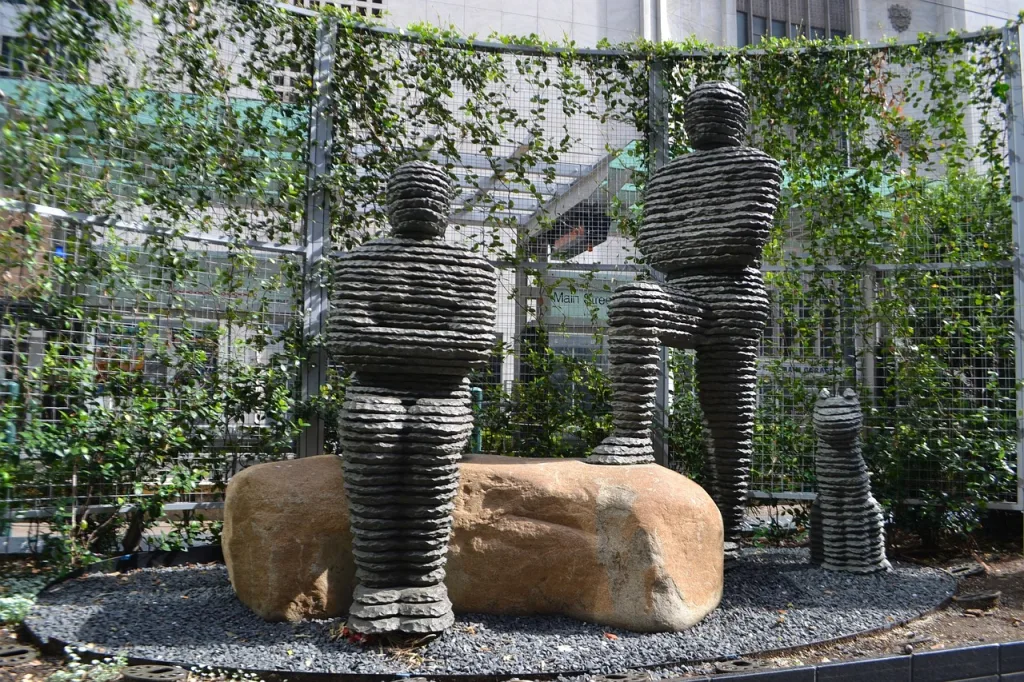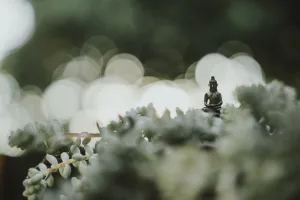Japanese gardens have long been admired for their natural beauty and tranquil atmosphere. One crucial element that contributes to the unique charm of these gardens is the strategic placement of rocks throughout the landscape. But why are rocks so significant in Japanese gardens? Beyond their aesthetic appeal, these rocks hold a deeper symbolic meaning that is rooted in Japanese culture and philosophy. By understanding their significance, we can gain a greater appreciation for the artistry and intention behind these serene spaces.

Understanding Japanese Gardens
Brief Overview of Japanese Gardens
Japanese gardens are renowned worldwide for their captivating beauty and timeless elegance. These meticulously designed spaces originated in Japan and have been cherished for centuries. Each garden is a masterful blend of carefully chosen elements that create a harmonious and serene environment. From vibrant flora to carefully positioned rocks, these gardens are designed to evoke a sense of tranquility and reflection.
Significance of Nature in Japanese Culture
Nature occupies a significant place in Japanese culture, and this reverence is reflected in their gardens. Drawing inspiration from the natural landscape, Japanese gardens aim to recreate the essence of nature in a controlled and balanced environment. They serve as a sanctuary where people can connect with the natural world and find solace in its beauty. Nature is not simply an aesthetic choice in these gardens; it is a reflection of the fundamental values and beliefs of Japanese culture.
Elements of a Traditional Japanese Garden
Traditional Japanese gardens consist of several key elements, each carefully selected and placed to create a specific ambiance. These elements include water features, bridges, lanterns, pathways, and of course, rocks. Rocks, in particular, play a central role in the composition and symbolism of Japanese gardens. Let’s explore their significance in greater detail.
Symbolism in Japanese Gardens
Importance of Symbolism
Symbolism is an integral part of Japanese culture, and it is no different in Japanese gardens. Symbolism adds depth and meaning to the design, allowing visitors to connect on a spiritual and emotional level. It creates a profound sense of harmony and tranquility. In Japanese gardens, every element, including rocks, carries its own symbolism, carefully selected to convey specific messages or evoke particular emotions.
Application of Symbolism in Garden Elements
Symbolism is not only attributed to the choice of elements within a garden, but also how these elements are placed and arranged in relation to one another. Balance and harmony are vital principles of Japanese garden design, and symbolism is an essential tool in achieving these qualities. Rocks, with their solid and enduring nature, are often used to represent stability, strength, and permanence.
Deepening the Appreciation Through Symbolism
Understanding the symbolism in Japanese gardens enhances the appreciation of their beauty and allows visitors to interpret the deeper meanings behind each element. By recognizing the intention and thoughtfulness behind the placement of rocks, visitors can engage in a more profound connection with the garden and gain a greater understanding of Japanese culture and philosophy.
Rocks as Central Element in Japanese Gardens
Role of Rocks in the Garden Landscape
Rocks, or ishi, hold a central role in Japanese garden design. They are not mere decorative features but serve as the foundation upon which the entire composition is built. Rocks are carefully selected and positioned to create a sense of balance and stability. They add a sense of permanence and timelessness to the garden, grounding the design in the natural world.
Variety of Rock Types Used
Japanese gardens feature a wide variety of rock types, each carefully chosen for its unique shape, color, texture, and symbolism. Some commonly used rock types include granite, limestone, sandstone, and basalt. The diverse selection ensures that each garden has its distinct character and meaning, adding further depth to the overall design.
Choosing and Placing Rocks in Japanese Gardens
The process of choosing and placing rocks in a Japanese garden is a meticulous art form. Gardeners carefully consider not only the appearance of the rocks but also their size, shape, and texture. Each rock is intentionally positioned to create a harmonious and balanced composition. The placement of rocks may give the illusion of natural formations, such as mountains, waterfalls, or islands, transporting visitors into a serene and contemplative realm.
Symbolic Meanings of Rocks in Japanese Gardens
Rocks as Symbols of Strength and Permanence
Rocks are often seen as symbols of strength, stability, and endurance in Japanese culture. Their unyielding nature represents the unchanging aspects of life and the resilience necessary to navigate its challenges. As visitors gaze upon these rocks, they are reminded of the power and permanence of nature and encouraged to find strength in the face of adversity.
Rocks Representing Land and Islands
In Japanese gardens, rocks are symbolic of land formations, such as mountains and islands. They represent the sacredness and beauty of the natural world. Landscapes are meticulously recreated using rocks to evoke a sense of being in a miniature representation of the larger Japanese landscape. The carefully crafted arrangement of rocks tells a story and transports visitors to a different place and time.
Metaphysical Properties of Rocks in Gardens
Rocks in Japanese gardens are believed to possess metaphysical properties. It is believed that certain rocks can attract positive energy, purify the surrounding environment, and bring good fortune to those who interact with them. These beliefs add an intriguing layer of spirituality to the garden experience, inviting visitors to engage with the rocks on a deeper level and benefit from their alleged powers.
Rocks as Pathways and Bridges
Rocks serve a practical purpose in Japanese gardens as well. They can function as pathways, enabling visitors to navigate the garden and explore its various elements. Additionally, rocks may be arranged in a way that creates bridges over streams or serves as stepping stones, enhancing the garden’s functionality while maintaining its aesthetic appeal.
Interpretation of Rock Arrangements
Understanding the significance of rock groupings
The arrangement of rocks within a Japanese garden is not arbitrary; it holds significant meanings. The sizes, shapes, and positions of rocks are carefully considered to create a specific atmosphere and convey particular messages. Groupings of rocks can represent mountains, waterfalls, or landscapes, inviting visitors to immerse themselves in the beauty of nature, even within a confined space.
The Role of Zen Buddhism in Rock Arrangement Interpretation
Zen Buddhism has profound influence in Japanese garden design, including the interpretation of rock arrangements. It emphasizes the importance of mindfulness, simplicity, and contemplation. Rocks in Zen-inspired gardens are often placed in a way that encourages meditation and deep contemplation. They serve as focal points for concentration, prompting visitors to reflect on the impermanence of life and the harmony found in nature.
Different Styles of Stone Arrangements
Japanese gardens encompass a range of different styles, each with its distinct manner of arranging rocks. Some common styles include the dry landscape garden (karesansui), the three-stone arrangement (sanzon iwagumi), the five-stone arrangement (gogyou-seki), and the horizontal stone (kikyaku-seki). Each style carries its interpretation and symbolism, adding further layers of meaning to the garden’s overall design.
Significant Rock Formations in Japanese Gardens
Dry Landscape Gardens (Karesansui)
Dry landscape gardens, known as karesansui or Zen gardens, are minimalist in design, predominantly featuring rocks and gravel. These gardens symbolize vastness and tranquility, often replicating natural landscapes, such as mountains or seas. By meticulously arranging rocks and raking patterns into the gravel, karesansui gardens create a visual representation of nature’s infinite beauty.
Three Stone Arrangement (Sanzon iwagumi)
Sanzon iwagumi is a popular rock arrangement style consisting of three carefully selected rocks. The tallest rock represents heaven, the middle one symbolizes humanity, and the smallest rock represents earth. This arrangement reflects the harmonious relationship between heaven, humanity, and earth, aiming to remind visitors of the interconnectedness and balance of all things.
Five Stone Arrangement (Gogyou-seki)
Gogyou-seki, or the five stone arrangement, is another common style found in Japanese gardens. This arrangement typically consists of five rocks, each representing one of the five elements: wood, fire, earth, metal, and water. The arrangement seeks to capture the dynamic balance of these elements, promoting a harmonious and prosperous environment.
Horizontal Stone (Kikyaku-seki)
Kikyaku-seki, or horizontal stone, is a distinct style that utilizes a single long and flat rock positioned horizontally. This rock represents stability, grounding, and the immovable force of nature. Its horizontal placement creates a sense of tranquility and encourages visitors to pause, reflect, and appreciate the garden’s beauty.
Holy Rocks and Spiritual Symbolism
Worshipping of Stones in Japanese Culture
The reverence for stones in Japanese culture extends beyond their use in garden design. Some rocks are considered sacred and are worshipped by locals. These holy rocks, known as ishi or kamiseki, are believed to possess divine energy. They are often placed in shrines or temples, where visitors can pay their respects and offer prayers.
Rocks as Symbols of Deities
In Japanese folklore and mythology, rocks are sometimes associated with deities and ancient spirits. They are believed to be vessels through which these celestial beings communicate with the mortal world. The placement of these rocks in a garden imbues the space with a spiritual presence, creating a connection between visitors and the divine.
Rocks as Spiritual Gateways
Rocks in Japanese gardens are often strategically placed to serve as spiritual gateways. They serve as portals to different realms, enabling visitors to transcend the physical world and enter a spiritual plane. Passing through these gateways is thought to purify the soul and foster a deeper connection with nature and the divine.
Water and Rock Associations
Symbolism of Rocks Near Water Features
Water is another integral component of Japanese gardens, and its association with rocks adds to the symbolism and beauty of these spaces. Rocks positioned near water features, such as ponds or streams, represent the union of land and water. They create a sense of balance between the solid and flowing elements, embodying the harmony that exists within nature.
Rocks as Waterfalls or Islands
Some rock arrangements intentionally mimic waterfalls or islands. Stacked rocks create the illusion of cascading water, while carefully positioned rocks in pond or lake gardens represent islands. These features evoke the natural beauty of Japan’s landscapes, allowing visitors to appreciate the country’s diverse and awe-inspiring geography.
Balance and Harmony Between Water and Rocks
The relationship between water and rocks in Japanese gardens is one of balance and harmony. This harmonious union represents the inseparable connection between the physical and spiritual realms. As visitors observe water gently flowing over rocks or reflecting their beauty, they are reminded of the delicate balance that exists in nature and are invited to find their own sense of tranquility and equilibrium.
Rocks in Japanese Tea Gardens
Importance of Rocks in Tea Ceremony Rituals
In Japanese tea gardens, rocks play a crucial role in the tea ceremony rituals. These gardens are designed to create a tranquil setting for tea gatherings. Rocks are strategically placed to create intimate seating areas and serve as rest points for guests during the ceremony. The presence of rocks encourages contemplation, stillness, and a profound appreciation for the simplicity and humility inherent in the tea ceremony.
Rocks as Resting and Viewing Points
Rocks in tea gardens serve as resting and viewing points for tea ceremony participants. They provide a sense of stability and groundedness, allowing guests to connect with the surrounding nature and find solace in its beauty. These rocks offer a space to pause, reflect, and fully immerse oneself in the meditative experience of the tea ceremony.
Tea Garden Rocks as Symbols of Humility and Simplicity
Tea gardens embody the principles of humility, simplicity, and mindfulness. Rocks within these gardens reflect these qualities, seeking to evoke a sense of calmness and introspection. They symbolize the simplicity of nature and remind participants of the importance of embracing a humble mindset, recognizing the beauty in the ordinary, and finding contentment in the present moment.
Maintaining and Caring for Garden Rocks
Significance of Regular Maintenance
To preserve the beauty and symbolism of rocks in Japanese gardens, regular maintenance is essential. Over time, weathering and natural elements can alter the appearance and structural integrity of the rocks. Regular maintenance ensures that the rocks remain visually appealing and maintain their intended symbolism, allowing visitors to continue to appreciate the garden’s aesthetic and spiritual qualities.
Methods of Cleaning and Preserving Rocks
Cleaning and preserving garden rocks require delicate care and precision. Rocks should be gently cleaned with a soft brush or sponge to remove dirt and debris. Harsh chemicals or abrasive cleaners should be avoided to prevent damage. Additionally, protective coatings or sealants may be applied to certain rock types to preserve their color and texture while safeguarding them against weathering.
Preserving the Symbolism and Integrity of Garden Rocks
Preserving the symbolism and integrity of garden rocks goes beyond their physical appearance. It involves regular observation and, when necessary, repositioning or replacing rocks to maintain the intended balance and harmony of the garden. Gardeners strive to uphold the original artistic vision, ensuring that the rocks continue to convey their symbolic messages and captivate visitors for generations to come.
In conclusion, rocks hold a profound and multifaceted significance in Japanese gardens. They provide visual interest, structural stability, and symbolic depth. The intentional selection, placement, and interpretation of rocks enrich the overall garden experience, inviting visitors to connect with nature, contemplate the passage of time, and find solace in the tranquility and beauty of these exquisite spaces. Japanese gardens, with their careful blend of elements and meticulous attention to detail, serve as timeless reminders of the harmony and interconnectedness that exists within the natural world.




